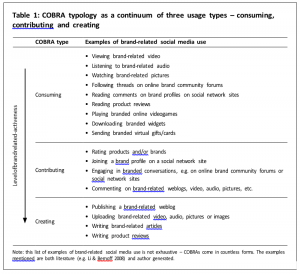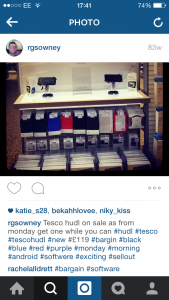Instagram delivers a channel where users and businesses can interconnect openly, and it is an idyllic place for businesses to associate with their existing and prospective consumers. Numerous brands are now greatly expending this social media outlet to improve their digital marketing scheme by increasing their brands coverage.
Instagram is available on both Apple and android systems and it can be opened on standard Internet browsers too, making it easily accessible. Instagram helps organisations to increase the amount of social shoppers they receive, as images and 15 second video recommendations are shared it creates a buzz around a company. Organisations can portray themselves in a more current and approachable way which appeals to the viewer. Encouraging user-generated contents emboldens a more advanced relationship, and can be inspired with hash-tags.Social media has renovated the way that consumer behave online (Kaplan & Haenlein 2010). Users are gradually becoming more powerful and persuasive in regards to the organisations they are networking about (Muñiz & Schau 2007; Cova & Dalli 2009). Furthermore, their digital exchanges are more influential on consumer behaviour than former types of promotion and marketing (e.g. Chiou & Cheng 2003; Villanueva et al. 2008). These social interactions have been referred to as ‘new forms of customer empowerment’ (Cova & Pace 2006)
This video explains tips for using Instagram as a business…
Shopify. (2014). Instagram for Business: How to Build an Audience of Followers for Your Brand.
Consumers’ online brand-related activities (COBRAs) have important significances for companies. To efficiently expect and prepare for these significance’s, it is vital to understand the consumer’s inspirations to become involved with brand-related social media (Daniël et al 2011). These outlets are insights into the consumer’s ideas and aspirations for the establishment.
Types of COBRA
A way of categorising users is by using the model created by Daniël et al (2011), illustrating three types of COBRAs, (1) consuming (2) contributing and (3) Creating.

Figure 1: Daniël et al (2011) Introducing COBRAs,
Consuming COBRA
Daniël et al (2011) recognises that the ‘consuming COBRA’ is the minimum type of participation and involves observation of online brand related activity. Brand related activity could consist of online chats, on forums or review sites. This type of user may also “download branded widgets, play branded games and send branded virtual gifts”
Contributing COBRA
The ‘contributing COBRA’ is in the middle ground of brand related content, implementing both “user-to-content and user-to-user interactions about brands” (Daniël et al 2011). Users who exchange about this type of brand-related content are likely to chat on on a brand’s fan page. A brands fan page is the area that they can share ideas and opinions.
Creative COBRA
The creative COBRA is the most involved type of brand related activity, it consists of a user who actively creates and publishes the content. This user is interested in the latest developments and can have their own fan following who look to this person for news and updates.
McQuail’s (1983) four-category classification of motivations for COBRAs
McQuail’s (1983) four-category classification of motivations is applicable to social media. Four categories are (1) entertainment, (2) integration and social interaction, (3) personal identity and (4) information motivations
Entertainment
This motivation includes the emotions the user feels when involving themselves with COBRAs. Users are likely to be passionate about the product or service and so can become excited by new or positive content and can be angered by irrelevant or negative content. Users gain entertainment from COBRA’s, they can relax and enjoy the escapism aspects of online presence. Instagram can be used as an outlet to distract users from everyday life. The following user is passionate about the product and can discuss their opinions openly, becoming excited about the content. The users opinions are being recognised through likes and this is a fulfilling experience and part of the entertainment.
Figure 4: w_obiektywie_ani. Instagram (2015).Private user profile.
This post uses the hash-tag ‘#52bookchallenge’, this was very popular for Kindle users as Kindle tablets are well-known for their book feature and book store app. Using the hash-tag to promote reading will in turn encourage Kindle users to talk about there Kindles on Instagram to there friends and this will raise awareness of the product.
The following user is an example of entertainment…
Figure 2: Em.Pawlowski. Instagram (2015). Private user profile.
The user is excited about their new purchase, creating a positive recommendation with the hash-tag ‘#itslove’
Integration and social interaction
This motivation is about how users feel part of a society, and the online interactions create relationships and a sense of community. Kaye (2007) calls this “affiliation with like-minded others”, meaning users interact in order to gain emotional support and gratification.
The users are gaining recognition from other users as well as information, the exchange is an example of an online community in which users can create bonds. An example of a user gaining recognition is as follows…
Figure 5: Aprilamsss. Instagram (2015). Private user profile.
Figure 5 illustrates a user who has a personal connection with the brand, highlighting their loyalty towards the brand with a post about acquiring multiple Samsung devices. This loyalty creates a positive perception of the brand; viewers of the post may consider the devices due to the recommendation.
Personal identity
The motivation ‘personal identity’ related to the impression that users want to give about themselves. Commonly Instagram users create an online presence to portray their lives differently, usually better than reality. Users can gain acknowledgment of their opinions and this gives a sense of fulfilment. Boyd (2008) and Bumgarner (2007) have recognised how important the ‘impression management is, naming it as an important motivator.
The following exchange is an example of creating an impression; it fulfills the McQuail’s (1983) four-category classification of the personal identity motivations. The user wants to be known as a reputable critic, capable of making trustworthy observations and reviews. The exchange is an example of gaining recognition from other users and expressing a review.
Figure 6: Alexcodek. Instagram (2015).Private user profile.
This conversational exchange illustrated took place below a post by Intel, in which the users are discussing the tablets strengths and weaknesses.
Information
Information can be a good motivator, and information may be retrieved by users researching how Instagram is used. The information could be about the opinions of Instagram users as well as the demographics of the users. This type of information can be useful in reducing risks.
Examples of posts which fit into McQuail’s (1983) four-category classification of motivations for COBRAs are as follows…
An example of information sharing is as follows…
Figure 3: Rgsowney. Instagram (2015). Private user profile.
This Instagram user is making others aware of the hudl sale in Tesco, thus raising awareness of the product as well as creating hype around it. Using the hash-tag ‘#exciting’ shows that this is a positive post and that the tablet is worthy of praise. Businesses can benefit from users like this as this type of post can encourage more sales. The organisation ‘Tesco’ could share this post on their own page to ensure that the post reaches the maximum amount of people.
Ways for tablet sector companies to encourage COBRAs
Figure 7: AmazonFire. Instagram (2015). Private user profile.
Organisations can encourage user participation by evoking memories. This is the Amazon Fire Instagram page, reflecting on an older post, and this is apparent as the organisation has used the hash-tag ‘#regram’. This is a useful hash-tag as it allows organisations to reflect on older material without it seeming outdated. Another hash-tags with a similar purpose is ‘#throwback’, also allowing old content to be re-released. This type of hash-tag could be used in your tablet sector company in order to reflect upon past content which the audience will remember.
Figure 8: Intel. Instagram (2015).Private user profile.
Organisations can encourage users to take notice of their tablet by posting information about the product, offering a chance for users to make comparisons to other tablets. The post by Intel provoked a user to remark “Apples better”. This could motivate further discussion and debate on the page; it could also inspire users to create posts about the product.
Figure 9: AmazonFire. Instagram (2015). Private user profile.
Organisations can use Instagram to create relationships with consumers. This is the Amazon Fire Instagram page, and this page is interesting to viewers as there are posts which are unrelated to the product. This can reassure users that the aim of the business is to connect with the consumers and create useful and interesting Instagram posts. The organisation should avoid creating too many advertisements and obvious sales techniques as this can discourage users. If users feel like they can trust the organisation they are more likely to produce positive COBRAs.
References
- Alexcodek. Instagram (2015). Private user profile. Available: https://instagram.com/. Last accessed 10/05/15
- AmazonFire. Instagram (2015). Private user profile. Available: https://instagram.com/. Last accessed 10/05/15
- AmazonFire. Instagram (2015). Private user profile. Available: https://instagram.com/. Last accessed 10/05/15
- Aprilamsss. Instagram (2015). Private user profile. Available: https://instagram.com/. Last accessed 10/05/15
- Boyd, D. (2008) Why youth (heart) social network sites: the role of networked publics in teenage social life, in Buckingham, D. (ed.) Youth, Identity, and Digital Media. Cambridge, MA: MIT Press, pp. 119–142.
- Bumgarner, B.A. (2007) You have been poked: exploring the uses and gratifications of Facebook among emerging adults. First Monday, 12(11). Available online at: http://firstmonday.org/htbin/cgiwrap/bin/ojs/index.php/fm/article/view/2026/1897 (accessed on 28 August 2009).
- Cova, B. & Dalli, D. (2009) Working consumers: the next step in marketing theory? Marketing Theory, 9(3), pp. 315–339.
- Cova, B. & Pace, S. (2006) Brand community of convenience products: new forms of customer empowerment – the case ‘my Nutella The Community’. European Journal of Marketing, 40, pp. 1087–2005.
- Chiou, J.-S. & Cheng, C. (2003) Should a company have a message board on its web sites? Journal of Interactive Marketing, 17(3), pp. 50–61.
- Daniël G. Muntinga, Marjolein Moorman & Edith G. Smit (2011) Introducing COBRAs, International Journal of Advertising: The Review of Marketing Communications, 30:1, 13-46
- Em.Pawlowski. Instagram (2015). Private user profile. Available: https://instagram.com/. Last accessed 10/05/15
- Haipey_. Instagram (2015). Private user profile. Available: https://instagram.com/. Last accessed 10/05/15
- Intel. Instagram (2015). Private user profile.
- Intel. Instagram (2015). Private user profile. Available: https://instagram.com/. Last accessed 10/05/15
- Kaplan, A.M. & Haenlein, M. (2010) users of the world, unite! The challenges and opportunities of social media. Business Horizons, 53, pp. 59–68.
- Kaye, B.K. (2007) Web site story: an exploratory study of blog use motivations, in Tremayne, M. (ed.) Blogging, Citizenship and the Future of Media. New York, NY: Routledge, pp. 127–148.
- Lasswell, H.D. (1948) The structure and function of communication in society, in Bryson, L. (ed.) The Communication of Ideas. New York, NY: Harper, pp. 37–51.
- McQuail, D. (1983) Mass Communication Theory. London: Sage Publications.
- McQuail, D., Blumler, K., & Brown, J. (1972) The television audience: a revised perspective, in McQuail, D. (ed.) Sociology of Mass Communication: Selected Readings. Middlesex: Penguin, pp. 134–165.
- Muñiz, A.M. & Schau, H.J. (2007) Vigilante marketing and consumer-created communications. Journal of Advertising, 36(3), pp. 35–50.
- Rgsowney. Instagram (2015). Private user profile. Available: https://instagram.com/. Last accessed 10/05/15
- Shopify. (2014). Instagram for Business: How to Build an Audience of Followers for Your Brand. Available: https://www.youtube.com/watch?v=VhfX21jz17c. Last accessed 10/05/15.
- Villanueva, J., Yoo, S. & Hanssens, D.M. (2008) The impact of marketing-induced versus word-of-mouth customer acquisition on customer equity growth. Journal of Marketing Research, 45(1), pp. 48–59.
- w_obiektywie_ani. Instagram (2015). Private user profile. Available: https://instagram.com/. Last accessed 10/05/15








